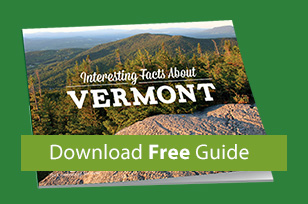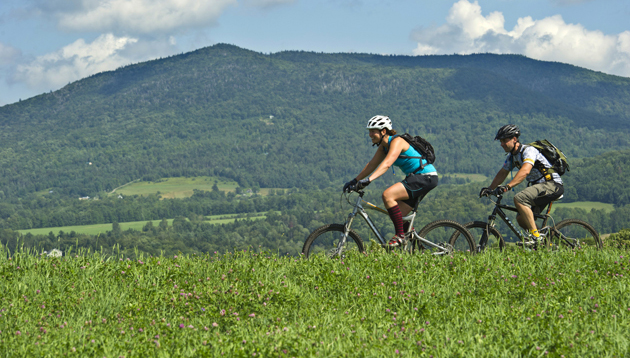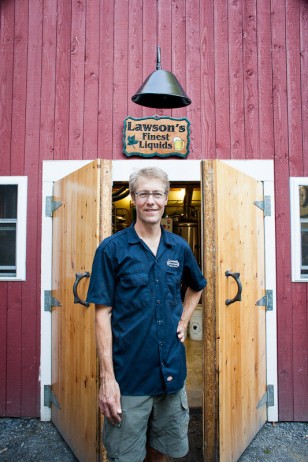By Greg Gerdel
The very mention of Vermont brings to mind mountains; the Green Mountain State is also a land of rivers, lakes, and streams. The discordant continental plates that created the Green Mountains also carved the basins of Lake Champlain, Memphremagog, Willoughby, Crystal and many smaller glacial lakes dotting the landscape. Likewise the rivers and streams that course through the valleys have their origin in the grinding descent of the glaciers from the north, and their subsequent retreat.
Like the earliest navigators, today’s visitors paddle these waterways and follow the footpaths. And while later generations have moved roads to higher ground, most of Vermont’s highways and byways still wind along these scenic shores, river banks, and mountain trails.
Honoring this heritage, Vermont has created (or perhaps, “discovered”) nine officially designated byways and shares in the federally designated Connecticut River Byway (www.vermont-byways.us). These inherently scenic byways also celebrate the history, geography, archeology, culture and recreational opportunities found along their routes.
Vermont offers unmatched possibilities for hiking, biking, kayaking, fishing, and camping. At the same time, exploring Vermont’s waters and woodlands reveals undiscovered stories of Vermont’s geologic creation, its native people, and our nation’s early growth industries —lumber, stone quarries, agriculture, and the railroads.
In the Forest
By mid-spring woodland trails are firm and lush, teasing you with more backcountry paths than any one person could hike over many years. The Scenic Route 100, Mad River, and Green Mountain Byways correspond with much of Vermont’s legendary Long Trail as together they trace a path along the granite spine of the Green Mountains, while the Shires of Vermont and the Crossroad of Vermont Byways run perpendicular to the Trail in the southern and central parts of the state.

The Long Trail is the oldest long distance hiking trail in the U.S. This “footpath in the wilderness” stretches 273 miles and is maintained by the Green Mountain Club, which carries its own 100-year legacy (www.greenmountainclub.org).
One of Vermont’s most distinctive peaks, Camel’s Hump, graces the Long Trail near the center of the state. The two-humped summit created by glacial movement consists of 550 million-year-old schist, typical of the rock found on many of Vermont’s higher peaks.
The southern third of the Long Trail is joined by the Appalachian Trail until it turns east near the Killington and Woodstock regions. Both of these famed trails are accessible at many points, or by side trails. A backcountry overnight will cleanse the soul… but if a Jacuzzi tub is the preferred way to cap off the day, consider a day hike from a resort, inn, or b&b. Trailhead access as well as guided hikes are available near many junctions from properties such as Inn at the Long Trail or the Inn of the Six Mountains (www.innatlongtrail.com, www.sixmountains.com).
The Green Mountain National Forest and Vermont State Parks offer an abundance of trails, varying from day hikes to “storytelling” nature paths for the adventurous toddler (www.fs.usda.gov/greenmountain, www.vtstateparks.com). Lace up the boots of even the littlest ones; ideas for hikes with children abound.
If a lakeside meander is more your style, immerse yourself in history at the 81-acre Goodsell Ridge Preserve on Isle la Motte. Located at the northern end of the Lake Champlain Byway, the Isle is home to a remarkable national geologic treasure, the Chazy Reef. Formed 480 million years ago where Zimbabwe is today and thrust northward by tectonic action, the reef illustrates the story of Earth’s early development, revealing one of the world’s oldest fossil layers.
Camping in Vermont provides ready access to the outdoor recreation or simply as a place to enjoy the quiet beauty of the woodlands. With Vermont’s 52 state parks and nearly 100 private campgrounds, it’s possible to find a campsite in every part of the state (advance reservations are encouraged) (www.vtstateparks.com, www.campvermont.com). Choose the park that is right for you; campgrounds and State Parks offer a variety of services including water spigots, WiFi, and enhanced accessibility as well as more rustic camping.
Among the beaches, walking paths, hiking trails and picnic areas in Vermont’s campgrounds lay indications of ancient times. Londonderry’s Jamaica State Park, which lies along the Scenic Route 100 Byway, was the site of a major archeological dig revealing artifacts from 7000 years ago (www.vtstateparks.com/htm/jamaica.htm). The Park also features “The Dumplings” along the West River, boulders that stand out from native rock that were deposited in the environment by glacial ice. A night in a tentsite, lean-to, cabin or cottage includes the privilege to wander.
On Two Wheels
Biking has been part of Vermont’s outdoor constitution since the days of youth hostel tours in the 1960s. With tours meandering along the peaceful greens of steepled villages and historic early New England architecture, companies such as Discovery Bicycle Tours have created an inn-to-inn cycling tradition that has grown internationally (www.discoverybicycletours.com).
The Lake Champlain Byway and the Northeast Kingdom Byway are popular biking destinations. From Addison County’s fertile, rolling agricultural shores to Burlington’s urban, 7.6 mile recreational path stretching to the Champlain Islands, to the rolling hills and covered bridges leading up through Vermont’s bucolic Northeast Kingdom toward Quebec, one good turn deserves another.

Mountain biking will beckon you from the road to the forest, to the pasture and into the mountains. For more diverse terrain, the single track of Burke’s Kingdom Trails (www.kingdomtrails.com) presents heart-pumping exhilaration on Darling Hill and Burke Mountain; check out Stowe’s Trapp Family Lodge for a varied network of trails and a post-cycle signature lager to boot (www.trappfamily.com).
For those who prefer a quicker ascent, Vermont’s alpine and cross country resorts such as Mount Snow, Stratton, Sugarbush, Stowe Mountain Resort, and Burke offer bike terrain in summer and fall (www.skivermont.com). Though much of Vermont was devoted to sheep grazing in the late 1800s, trail time will reveal a thick network of forest, streams, and natural open spaces that have woven the fabric of Vermont for centuries.
Vermont hosts more than a half dozen “rail trails,” forested bike paths that have been created from abandoned railway corridors. Scenic and gentle in grade, the trail originating in Castleton along the Stone Valley Byway follows the former Delaware & Hudson Railroad. Peddling through the quiet forest, observe evidence of an era when railways and their busy depots were the hubs of America’s economy. The Vermont Bikeways Map shows the routes of the state’s rail trails (http://www.vermontvacation.com/biking.aspx).
On the Water
Catch the prevailing wind while sailing Vermont’s more expansive lakes; paddle the many rivers, smaller lakes and ponds with the help of canoes, kayaks, and more recently, paddleboards. Access to the water is readily available with rentals of almost every type at a variety of locations.

River trails and lake tributaries were trade pathways for several centuries of North American history and still require your occasional portage. Likewise, Vermont’s rivers were used to generate electricity to fuel mills. Evidence of the early wool, grist, paper, and lumber milling industries may be observed from canoe or kayak in many larger rivers, such as the Connecticut River, which defines Vermont’s eastern border, makes up the Connecticut River Byway, and hosts a substantial section of the Northern Forest Canoe Trail across northern Vermont (www.northernforestcanoetrail.org).
Vermont’s western Lake Champlain Byway is named for Vermont’s largest lake, which played a pivotal role in the Revolutionary War. While paddling the lake, imagine the fleets of gunboats, shipwrecks, and hundreds of troops and artillerymen who battled for independence; the Lake Champlain Maritime Museum brings this history to life with exhibits, artifacts, and archeological projects through its own Maritime Research Institute (www.lcmm.org). After the war, the Lake served as an artery for goods and the settlement of the region.
Anglers will find more than 20 species of game and panfish in Vermont waters, from rainbow, brook, or lake trout, to perch, bass, or pickerel (www.vtfishandwildlife.com). The Scenic Route 100 Byway’s West River Salmon Hole marks the site where a group of French and Native Americans ambushed British soldiers in 1748. As with many of Vermont’s larger rivers, for thousands of years Native Americans traveled the West River by canoe, following a major transportation route between the Connecticut River and Lake Champlain. Destinations such as the Batten Kill, the scenic river that straddles the state to the south and follows the Shires of Vermont Byway, are legendary for fly fishing.
A pioneer of the fishing tradition, the nation’s oldest mail-order retailer originated through the sale of fishing tackle. In 1856, Charles Orvis opened up shop in Manchester at the intersection of what is now the Stone Valley and Shires of Vermont Byway. Orvis came to be recognized as having a major influence on the nation’s fly fishing culture and industry (www.orvis.com).
Laced as it is with rivers and streams, Vermont has an abundance of ways to get into the water as well. Some of Vermont’s most accessible swimming lies adjacent its byways, such as Harriman Reservoir along the Molly Stark Byway, Lakes Saint Catherine and Bomoseen along the Stone Valley Byway, and Moss Glen Falls along the Mad River Byway. From sandy beaches on lakes and ponds to tucked-away woodland swimming holes, exploring the many places for cooling off on a hot day is one of summer’s great pleasures.
Get outside in Vermont… breathe deeply, have fun, explore, and learn from an intimate perspective about forces that, over time, have shaped Vermont’s distinctive landscape, communities and way of life. The seasons, natural resources, and history continue to define when, where and how Vermonters live within one of the world’s most beautiful landscapes.
Greg Gerdel is the research and operations chief for the Vermont Department of Tourism and Marketing.
This piece was originally published in the Vermont Vacation Guide, which is produced by the Vermont Chamber of Commerce.
Photos courtesy of Vermont Department of Tourism and Marketing





